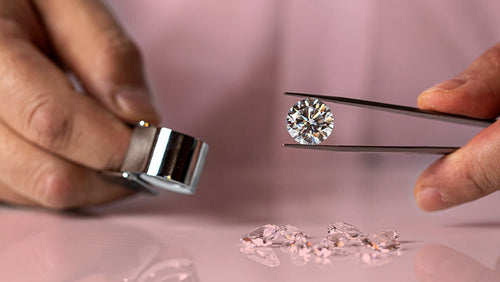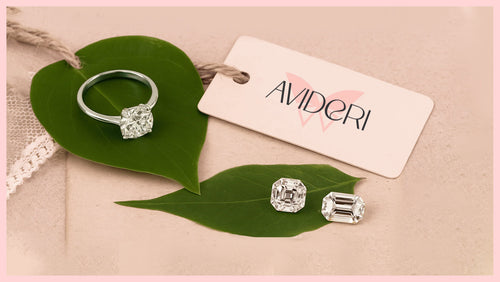Table Of Contents
- What Are Lab Grown Diamonds?
- Why Choose Lab-Grown Diamonds?
- Key Reasons to Choose Lab-Grown Diamonds
- How Are Lab Grown Diamonds Made? The Core Processes
- HPHT (High Pressure High Temperature) Process
- CVD (Chemical Vapor Deposition) Process
- Lab Grown Diamond Process: Step-by-Step Overview
- How Long Does It Take to Grow a Diamond in a Lab?
- Conclusion
- FAQS
Lab grown diamonds are becoming a popular alternative for exquisite jewelry because they are ethically sourced and cheap. How are lab grown diamonds made? Many people want to know. This blog clearly explains how experts make diamonds in a lab and what they do.
A microscopic diamond seed is put inside a specific machine to start the process of making diamonds in a lab. The two basic ways that HPHT and CVD copy natural circumstances are. The seed eventually matures into a diamond. It takes a few weeks to make these lab grown diamonds, and the end product is a diamond that looks exactly like one found in the ground.
What Are Lab Grown Diamonds?

What Are Lab Grown Diamonds? These actual diamonds that were made in labs with cutting edge technology. Lab grown diamonds develop in controlled environments, which is different from mined diamonds. They are the same in every way as natural diamonds, including how they look and how they work. People often want to know how lab grown diamonds are made. Science knows the answer, either through HPHT or CVD techniques.
A diamond seed is the first step in the process of making a diamond in a lab. In HPHT, crystals develop around this seed when there is a lot of heat and pressure. A gas with a lot of carbon forms diamond layers on the seed in CVD. This is how diamonds grown's in a lab. Do you want to know how to manufacture lab grown diamond or how diamonds grown in a lab? The process of generating lab grown diamond is clean, modern, and good for the environment.
Why Choose Lab-Grown Diamonds?

Lab grown diamond are becoming the top choice for modern customers. At the the core of this movement is the question: how are lab grown diamond made? These diamonds made with cutting edge technology that simulates the conditions that exist deep beneath the Earth. They have the same shine and strength as mined diamonds.
The process of making lab grown diamond is clean, efficient, and easy to follow. A lot of people want to know how lab grown diamonds made. The answer is high tech chambers where diamonds develop one layer at a time using carbon, heat, and pressure. This way of creating diamonds in a lab doesn't hurt people or the environment.
Key Reasons to Choose Lab-Grown Diamonds

- Ethical and Environmental Benefits: Lab grown diamond are better for the environment than mined diamonds. They don't include unethical labor practices or harmful mining circumstances. If you're curious in how diamonds grown in a lab, you should know that the method uses less water and energy. This makes them a cleaner, greener choice for eco minded shoppers.
- Cost Effectiveness: People who want to know how to make lab grown diamond generally also want to know how much they cost. These diamonds cost less than mined ones. The process of making lab grown diamonds cuts down on the costs of mining and shipping, so you can get bigger and better gems for less.
- Growing Popularity in the Jewelry Market: More and more people are learning how lab grown diamonds are made, which is making them more popular. Now, the best designers use them in rings, necklaces, and earrings. The process of lab grown diamonds in a lab has gotten a lot better, which has led to higher quality stones that look good to both classic and modern tastes.
How Are Lab Grown Diamonds Made? The Core Processes
How Are Lab Grown Diamonds Made? The HPHT process is one of the modern methods used to make lab grown diamond. This procedure for making diamonds in a lab uses high pressure and temperature to simulate the conditions on Earth. Carbon sources and growth chambers are two tools that help diamonds develop. Advanced machinery used to create diamonds layer by layer from a small seed in the lab grown diamond making process.
HPHT (High Pressure High Temperature) Process

The HPHT procedure is one of the first ways to make diamonds in a lab. It starts with a small diamond seed. This seed is put in carbon and placed under very high pressure and heat. The carbon melts over time and starts to build around the seed, making a diamond that was made in a lab.
How the HPHT process mimics Earth’s natural diamond formation
So, how can they make lab grown diamond that seem like natural ones? The HPHT method replicates the high heat and pressure that are present deep in the Earth's mantle. Like wild diamonds, which take millions of years to grow underground, lab grown diamond grow in just a few weeks in controlled but similar lab settings.
Step-by-step breakdown
- Step 1: A diamond seed selected and placed in carbon.
- Step 2: The seed undergoes 1.5 million PSI pressure and 2,700°F temperature.
- Step 3: Carbon melts and forms layers on the seed.
- Step 4: A diamond crystal begins to grow naturally.
- Step 5: The grown diamond cooled slowly and then cut.
Tools and technology used
The instruments used to make lab grown diamonds are very high tech. Big presses create a lot of heat and pressure. Temperature control chambers keep the right conditions for growth. Skilled experts use digital software and precise tools to keep an eye on every stage and make sure that every diamond is of the highest grade.
CVD (Chemical Vapor Deposition) Process

When you make diamonds in a lab using CVD, you start by putting a thin diamond seed inside a vacuum chamber. They add gasses that are high in carbon, heat them up, and break them down. This lets carbon atoms cling to the seed and make layers. Unlike HPHT, which employs extreme pressure, this procedure for generating lab grown diamond slowly makes real diamonds.
How CVD creates diamonds layer by layer
The first step in generating lab grown diamond is to put a small diamond seed in a vacuum chamber. Carbon is often used to make this seed. CVD employs a gas that is full of carbon to slowly make the diamond. The carbon sticks to the seed and makes a crystal one layer at a time, just like in nature.
Step-by-step process with simplified scientific explanation
Step 1: A thin slice of diamond seed placed in a sealed chamber.
Step 2: The chamber filled with gases like methane and hydrogen.
Step 3: Microwaves heat the gases into plasma, breaking carbon bonds.
Step 4: Carbon atoms land on the seed, building the diamond layer by layer.
Step 5: The diamond grows over several weeks and then cut and polished.
Differences in outcomes compared to HPHT
The CVD method for making diamonds in a lab allows you better control over how clear the diamonds are than the HPHT approach. HPHT is like pressure from deep in the earth, while CVD is slower and more accurate. CVD diamonds are often more purity and less likely to have metal inclusions, which makes them more desirable in many circumstances.
Lab Grown Diamond Process: Step-by-Step Overview

How Are Lab Grown Diamonds Made? As couples hunt for diamonds that are environmentally friendly and ethically sourced, this research is becoming more popular. We at Avideri want to make it easy for you to understand how lab grown diamonds are made. Let's look at every step that explains how diamonds grown in a lab made.
Step 1: Choosing the diamond seed
To start making lab grown diamond, you need to pick a little diamond seed. This seed what the new diamond is built on. It usually comes from a piece of real diamond. The lab puts this seed in a safe place. The seed you choose will determine how clear and high quality the diamond is in the end. This stage is really important.
Step 2: Growth chamber and environmental controls
The seed goes into a growing chamber when it's ready. The chamber simulates the extreme heat and pressure present in the Earth's inside. It completely sealed and uses both HPHT or CVD. This step in the process of making lab grown diamond helps the seed turn into a genuine diamond. Good control makes certain the stones grow without any problems.
Step 3: Growth time and crystal formation
Depending on size, the growth phase can last from two to three weeks. Carbon atoms continue to the seed during this time. They slowly create the diamond one layer at a time. This is the main way that diamonds made in a lab. At this point, the crystals develop on their own. The process stops when the full size reached.
Step 4: Cutting, polishing, and certification
After it grown, the raw diamond is taken out. Just like a mined diamond, skilled hands cut and polish it. Every diamond carefully graded. This means looking at the color, clarity, and cut. Every stone gets a certificate from the labs. This last step in manufacturing lab grown diamond makes sure they are of high quality and that customers can trust them.
How Long Does It Take to Grow a Diamond in a Lab?

How are lab grown diamonds made? The answer depends on how you do it. HPHT and CVD are the two most popular ways. Each one has its own way of making lab grown diamond and takes a varied amount of time.
| Method | Growth Time | Temperature |
|---|---|---|
| HPHT | 10–14 days | 1,300–1,600°C |
| CVD | 3–4 weeks | 700–900°C |
Factors Affecting Growth Time
- Size of the diamond
- Purity of carbon source
- Precision of temperature and pressure
- Technology used in lab grown diamonds making process
Understanding how lab grown diamonds made helps you appreciate their value. The lab grown diamonds process is clean, ethical, and precise.
Conclusion
Knowing how lab grown diamonds made helps us appreciate why these ethical gems are worth so much. Putting carbon under a lot of pressure and heat is part of the procedure for making lab grown diamonds. The process that produces lab grown diamond makes stones that look and feel much like mined ones, but they are better for the environment and cost less.
In short, the process of making lab grown diamond uses advanced technology and either HPHT or CVD techniques. So, how do they produce diamonds in a lab? With care and precision, please. The way lab grown diamond manufactured has a big effect on the jewelry business since they are beautiful, long lasting, and cheap all at the same time.
FAQS
Q: How are lab grown diamonds made?
Lab grown diamonds made using HPHT or CVD methods that replicate the natural diamond growing process inside a lab.
Q: What is the lab grown diamond process?
The process involves high heat and pressure or chemical vapor deposition to grow diamonds from a carbon seed in a lab.
Q: How do they make lab grown diamonds?
Scientists grow diamonds in a lab by mimicking Earth's natural conditions using controlled heat, pressure, and carbon gases.
Q: How to make lab grown diamond at home?
Lab diamonds require complex, high tech machines and not be made at home. They need precise pressure and temperature control.
Q: What is the difference between HPHT and CVD?
HPHT uses intense heat and pressure, while CVD grows diamonds layer by layer using carbon rich gases in a vacuum chamber.
Q: Are lab grown diamonds real diamonds?
Yes, lab grown diamond are physically, chemically, and optically identical to mined diamonds, just made in a lab setting.
Q: How long does it take to make a lab grown diamond?
It usually takes 2 to 10 weeks to grow a diamond, depending on size and the method used HPHT or CVD.
Q: Is the lab grown diamond process eco friendly?
Yes, lab grown diamond are more eco friendly than mined ones as they use fewer resources and cause less environmental damage.
Q: Are lab grown diamond cheaper than natural diamonds?
Yes, they are generally 20 - 40% less expensive than natural diamonds, offering a more affordable luxury alternative.
Q: Do lab grown diamonds last as long as mined ones?
Absolutely. Lab grown diamond have the same hardness and durability as natural diamonds, lasting a lifetime with proper care.






